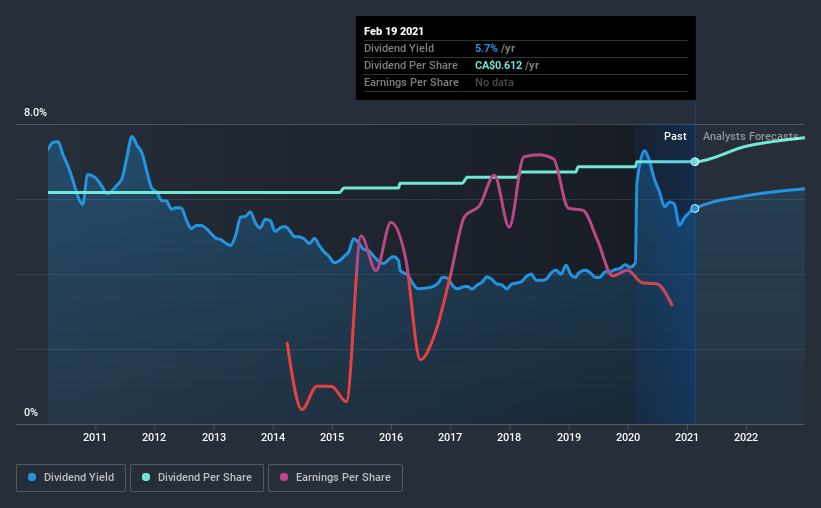We Wouldn't Be Too Quick To Buy Chartwell Retirement Residences (TSE:CSH.UN) Before It Goes Ex-Dividend
Some investors rely on dividends for growing their wealth, and if you're one of those dividend sleuths, you might be intrigued to know that Chartwell Retirement Residences (TSE:CSH.UN) is about to go ex-dividend in just four days. Investors can purchase shares before the 25th of February in order to be eligible for this dividend, which will be paid on the 16th of March.
Chartwell Retirement Residences's next dividend payment will be CA$0.051 per share, and in the last 12 months, the company paid a total of CA$0.61 per share. Looking at the last 12 months of distributions, Chartwell Retirement Residences has a trailing yield of approximately 5.7% on its current stock price of CA$10.65. Dividends are an important source of income to many shareholders, but the health of the business is crucial to maintaining those dividends. So we need to check whether the dividend payments are covered, and if earnings are growing.
View our latest analysis for Chartwell Retirement Residences
Dividends are usually paid out of company profits, so if a company pays out more than it earned then its dividend is usually at greater risk of being cut. Chartwell Retirement Residences reported a loss last year, so it's not great to see that it has continued paying a dividend. Given that the company reported a loss last year, we now need to see if it generated enough free cash flow to fund the dividend. If cash earnings don't cover the dividend, the company would have to pay dividends out of cash in the bank, or by borrowing money, neither of which is long-term sustainable. Dividends consumed 60% of the company's free cash flow last year, which is within a normal range for most dividend-paying organisations.
Click here to see the company's payout ratio, plus analyst estimates of its future dividends.
Have Earnings And Dividends Been Growing?
Stocks with flat earnings can still be attractive dividend payers, but it is important to be more conservative with your approach and demand a greater margin for safety when it comes to dividend sustainability. If earnings fall far enough, the company could be forced to cut its dividend. Chartwell Retirement Residences reported a loss last year, but at least the general trend suggests its income has been improving over the past five years. Even so, an unprofitable company whose business does not quickly recover is usually not a good candidate for dividend investors.
The main way most investors will assess a company's dividend prospects is by checking the historical rate of dividend growth. Chartwell Retirement Residences has delivered an average of 1.3% per year annual increase in its dividend, based on the past 10 years of dividend payments.
Remember, you can always get a snapshot of Chartwell Retirement Residences's financial health, by checking our visualisation of its financial health, here.
Final Takeaway
Has Chartwell Retirement Residences got what it takes to maintain its dividend payments? First, it's not great to see the company paying a dividend despite being loss-making over the last year. On the plus side, the dividend was covered by free cash flow." It's not the most attractive proposition from a dividend perspective, and we'd probably give this one a miss for now.
Having said that, if you're looking at this stock without much concern for the dividend, you should still be familiar of the risks involved with Chartwell Retirement Residences. Be aware that Chartwell Retirement Residences is showing 3 warning signs in our investment analysis, and 2 of those are a bit concerning...
We wouldn't recommend just buying the first dividend stock you see, though. Here's a list of interesting dividend stocks with a greater than 2% yield and an upcoming dividend.
This article by Simply Wall St is general in nature. It does not constitute a recommendation to buy or sell any stock, and does not take account of your objectives, or your financial situation. We aim to bring you long-term focused analysis driven by fundamental data. Note that our analysis may not factor in the latest price-sensitive company announcements or qualitative material. Simply Wall St has no position in any stocks mentioned.
Have feedback on this article? Concerned about the content? Get in touch with us directly. Alternatively, email editorial-team (at) simplywallst.com.

